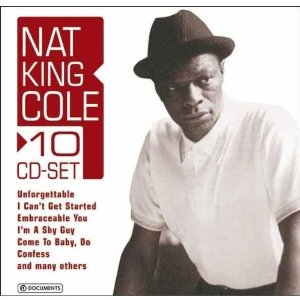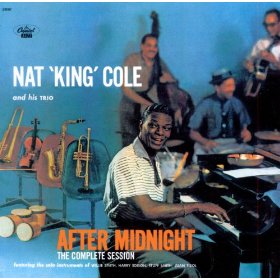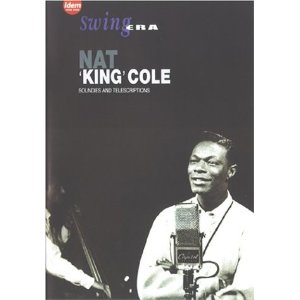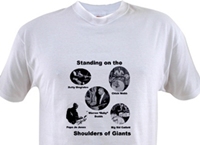
I can honestly say that this set expanded my musical skills and playing. I'll take it one step further: it should be required listening for every guitarist, bassist, pianist and drummer on the planet.
The reason for the first three is Nat was a virtuoso pianist who had the good fortune to have discovered Johnny Miller on bass and Oscar Moore on guitar. Each musician was in total command of his instrument, and together they were synergistic. Rhythmically, they rivaled the Great American Rhythm Section (Basie, Walter Page, Freddie Green and Papa Jo Jones), but they were also melodically and harmonically geniuses. To be sure, there were other members of the Trio as time passed, including another of my favorites on guitar: Irving Ashby. While the subsequent members were all amazing musicians in their own right, the trio with Miller and Moore stood out as magical in my opinion.
What drew me to the trio recordings contained in this set was the absence of a drummer on most of the tracks. That may sound silly since from my tag it's obvious that I am a drummer, but that is what makes this set all the more valuable. It opened my eyes (and ears) to how music can be both rhythmic and swing without a drummer. That forced me to carefully examine each instrument - bass, guitar and piano - and how they contributed to time, pulse and rhythm. Taking the time to dissect the music like that has changed my views on the role of a drummers (and humbled me by showing that a drummer can be dispensed with with the right musicians), thus making me a [hopefully] better drummer who is aware of what the other musicians are doing.
One other plus for drummers is because a great many tracks in this set are ensembles without one, this makes an ideal set of play-along tracks. I guarantee that your brush (and stick) chops will improve.
The November 4, 1949 concert wonderfully captured on Forgotten 1949 Carnegie Hall Concert is often touted as evidence that Nat was a virtuoso pianist.

However, do not think that this album is the first (or last) to show off Nat's virtuoso piano skills. His playing at Jazz at the Philharmonic concerts showcased those. Check out Jazz At The Philharmonic: featuring Body And Soult from a July 1944 concert for evidence.
What I love about this album, aside from the historical value, is the music itself. The fifteen tracks are pure Nat King Cole in jazz form. Another treat, because I am a Woody Herman fan, is when his herd joins in on Last Moon, adding icing to a musical cake for me.
Nat's trio at this concert did not include any of the original members. Irving Ashby replaced Oscar Moore on guitar and Joe Comfort took over Johnny Miller's bass spot. Plus, by this point in Nat's career, it was Nat King Cole and his Trio, not the Nat King Cole Trio. The third member was percussionist Jack Costanzo who played bongos on this album.
While Ashby is my second favorite trio guitarist and Comfort's bass was solid, the synergy of the original trio was not there in this performance. Or it just may be my imagination. Regardless, the music is consistently excellent and guarantees that this album will get a lot of play time.
The sound is fairly good for the period, although an audiophile would probably find fault. I wish Ashby and Comfort were a little more prominent in the mix, but that is a personal desire on my part and not a flaw in the recording as far as I am concerned.
One final recording that I highly recommend is After Midnight: The Complete Session:

This 1957 album had a fairly large ensemble (Nat on piano with Harry Sweets Edison on trumpet, Willie Smith on alto, Juan Tizol on trombone, Stuff Smith on violin, and a rhythm section comprised of Charlie Harris on bass, Lee Young on drums, John Collins on guitar and Jack Costanzo on bongos. A side note: Tizon composed Caravan (on the album) with Ellington, and Lee Young is Lester Young's brother. For those who do not know, Lester started out as a drummer himself, moving to alto then tenor sax.
The significance of this album is it brought Nat back to his jazz roots. By 1957 he was better known for his popular music and many had either lamented the fact that he was no longer playing jazz or were unaware of his roots. This album dispelled any doubts that he was - first and foremost - a jazz musician. It also reinforced his reputation as a virtuoso pianist instead of a vocalist who happened to play piano. Finally, this album is true to this post's theme: rhythm, swing and harmony.
Now I am going to take a step backwards and refocus on Nat's roots - his trio. A starting point that is Nat King Cole: Soundies & Telescriptionsn:

The music is divided into soundies and transcriptions.
Before proceeding allow me to explain soundies and telescriptions. A soundie is a mini music video that was popular during most of the 1940s. They were usually three minutes long and were presented on coin operated movie jukeboxes. A telescription - a television transcription - was also approximately three minute videos made for TV. The producer, Louis D. Snader, did made-for-TV shorts during 1951-52 and you will see the term Snader Telescription often used. Another distinction is soundies were often scripted and staged, while the telescriptions were live performances.
What this DVD contains is a set of 27 performances, divided between the two formats. Here are the performances:
- Route 66
- Sweet Lorraine
- Little Girl
- Home
- The Trouble with Me Is You
- Calypso Blues
- For Sentimental Reasons
- Thats My Girl
- Mona Lisa
- Because of Rain
- Too Young
- This Is My Night to Dream
- Nature Boy
- You Call It Madness
- Got a Penny Benny
- Come to Baby Do
- Errand Boy for Rhythm
- Is You Is or Is You Aint My Baby
- I'm a Shy Guy
- Who's Been Eating My Porridge
- Frim Fram Sauce
- Oh Kickeroony
- Now He Tells Me
- Breezy and the Bass
- Solid Potato Salad
- It's Better to Be by Yourself
- Always You
As you can see, the music covers a lot of Nat's most popular work from the period, and, in fact, some of his most enduring classics.
My preference is the soundies because I happen to like the synergy among the first trio - Nat, Oscar Moore and Johnny Miller. That is not to say that Irving Ashby who replaced Moore on guitar and Joe Comfort who replaced Miller on bass by the time the telescriptions were filmed are bad. Ashby remains one of my favorite jazz guitarists and Comfort is a solid bassist. And, of course, the addition of Jack Costanzo on percussion on the later trio added a lot and allowed adding songs like Calypso Blues to the repertoire. As an aside, the later trio (Ashby-Comfort-Costanzo) did a remarkable job backing Nat in the Forgotten 1949 Carnegie Hall Concert.
Bottom line: if you are a fan this is a great addition to a music library because you can not only enjoy hearing Nat, but watch him too. If your video does turn out to be out of synch, then play the audio without the video and pretend it's a CD. After all, you will have 27 tracks of some of his best performances to enjoy.
If you enjoyed the video and the selections, then this three CD set sinply titled Transcriptions will probably delight you also.

Check out the sound samples on the linked page to see why I recommend this set.
I am going to end this post with a Hollywood version of the apocryphal story of how Nat came to be a singer. Also note the subtle racism which was common for the era (in one case when Nat is in a hospital one of his managers calls him boy, which is not that subtle by today's standards, but was not even considered offensive [by whites] in the 1950s.
If you wish to dig deeper into Nat's life I recommend this book: Nat King Cole

This post is dedicated to the memory of Trevor Bougill 2/2/87 - 8/17/12.



No comments:
Post a Comment